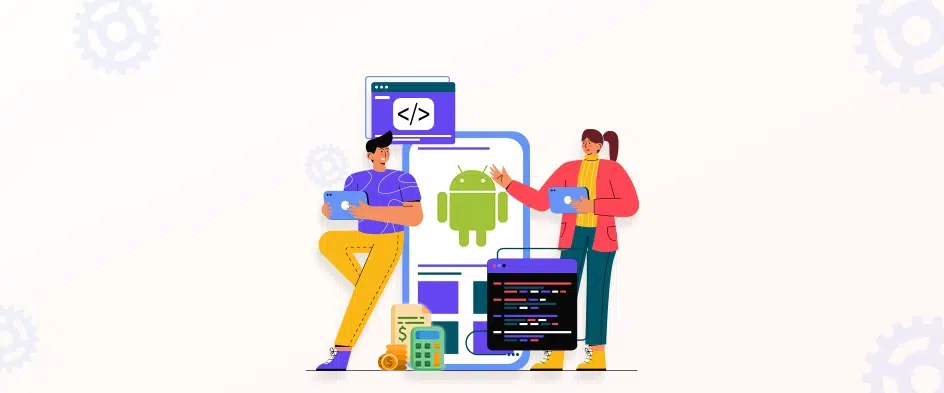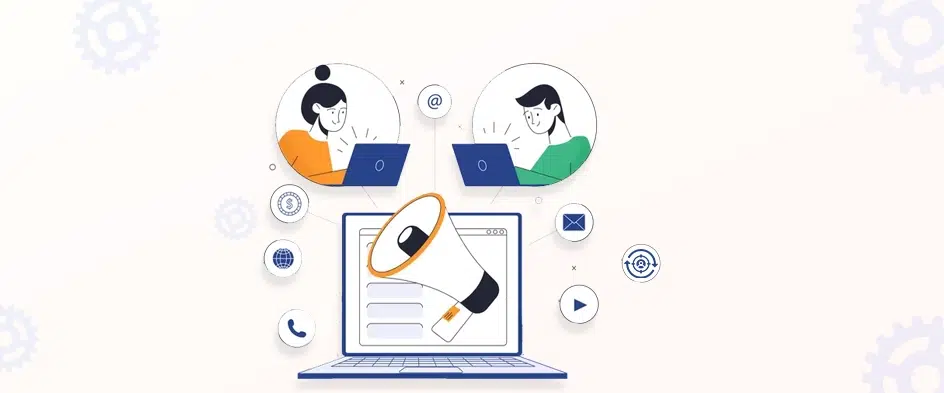Landing Page Best Practices: The Complete Guide to Optimization & Conversions

- 10 Minutes to read
Table of Content
- Why Implement Landing Page Optimization?
- Key Elements of an Effective Landing Page
- Best Practices for Creating Landing Pages
- Tips for Continuous Improvement of Landing Pages
- Conclusion
- FAQs on Landing Page Best Practices
Whether you are creating a small website (with just a few pages), an extensive enterprise website, or even a massive eCommerce site, the first page a visitor sees is the landing page. They are vital for successful online marketing. They convert visitors into customers or leads. With a great design, businesses can capture attention and motivate users to take action.
A landing page involves persuading visitors to take a specific action, such as buying a product, signing up for a free trial, or downloading a white paper. But what makes a good landing page? And how can you create one that drives results?
Well, the top web design companies cover a few landing page best practices when creating it for the site or app. We’ll cover them in this blog, along with the key elements that control the effectiveness of the landing page. Let’s start.
Why Implement Landing Page Optimization?
Implementing landing page optimization, also known as LPO, is crucial for any business striving for success in the online world. Here’s why:
Increased Conversion Rates
Landing pages are designed specifically to convert visitors into leads or customers. By optimizing your landing page, you can significantly increase your conversion rates, leading to more sales, leads, and subscribers.
LPO helps you identify and eliminate any friction points that might prevent visitors from taking the desired action. This can include improving your call to action, making your forms more concise, or optimizing your mobile experience.
Reduced Customer Acquisition Cost
Driving more leads and conversions from your existing traffic translates to a lower cost per acquisition (CPA). LPO helps you make the most of your marketing budget, allowing you to reach your target audience more efficiently.
Improved Brand Perception
A well-designed and optimized landing page can create a positive first impression of your brand. This can lead to increased trust and credibility, which ultimately translates to more conversions.
Valuable Insights and Data
LPO helps you gain valuable insights into how visitors interact with your page. By tracking user behavior, you can identify areas for improvement and optimize your page accordingly. This data-driven approach allows you to make informed decisions and continuously improve your landing page performance.
Enhanced Ad Performance
Landing pages can be used in conjunction with your paid advertising campaigns. When you send your paid traffic to a dedicated landing page, you can increase the effectiveness of your ads and maximize your return on investment (ROI).
Competitive Advantage
In today’s competitive online market, having high-converting landing pages is essential for standing out from the crowd. By optimizing your landing pages, you can gain a competitive advantage and attract more customers to your business.
Future Growth and Scalability
As your business grows, your landing pages need to be able to scale along with it. LPO allows you to create landing pages that are tailored to different segments of your audience and optimize them for different marketing campaigns. This ensures that your landing pages are always effective and generate consistent results.
In summary, implementing landing page optimization is a powerful strategy that can drive significant benefits for your business. So you can imagine the outstanding web design firms to improve your conversion rates and reduce your customer acquisition costs. That helps you gain valuable insights into your target audience.
Key Elements of an Effective Landing Page
Landing pages are important for conversions and lead capture. To make a great one, incorporate elements that engage visitors and encourage them to take action.
- Headline: Craft a headline that grabs attention. It should be simple, concise, and show the main benefits.
- Call-to-Action: Make sure the CTA stands out and is persuasive. It could be for a newsletter, purchase, or ebook.
- Visuals: Use quality images or videos that support your message and make the page visually appealing.
- Copy: The copy should be persuasive, engaging, and focused on the target audience’s needs. Highlight the benefits and use short sentences.
Along with these, A/B testing and mobile optimization are a must. You can also personalize the experience to match the interests of target audience segments. And since speed matters, you need to optimize image sizes and minimize scripts to make the page load quickly.
With these elements and optimization techniques, you can create a great landing page that brings in conversions and helps you reach your goals.
Best Practices for Creating Landing Pages
When trying to create a successful landing page, you need to follow certain practices. They can have a major influence on the success of your page. It leads to more conversions and customer involvement.
Keep Your Design Simple and Focused
When it comes to landing pages, less is truly more. A cluttered design overloaded with unnecessary elements creates a chaotic and overwhelming experience for visitors. This visual noise distracts them from your intended message and ultimately hinders their conversion journey.
Here’s what you need to consider for the simplicity of the landing page design:
- Minimalist design: Opt for clean lines, ample white space, and limited colors. This creates a sense of calm and allows your core message to stand out.
- Focused content: Avoid using text-heavy walls. Instead, utilize concise, impactful copy that highlights the benefits of your offer and compels action.
- Single call to action: Don’t confuse visitors with multiple options. Clearly define the single action you want them to take, whether it’s signing up for a free trial, making a purchase, or downloading a white paper.
- Uncluttered form fields: Minimize the number of form fields required for conversion. Only ask for essential information to streamline the process and avoid deterring potential leads.
Then comes the focus. A landing page with a laser-sharp focus delivers a targeted message that resonates with your audience. By eliminating distractions and concentrating on a single goal, you increase the likelihood of visitors taking the desired action.
Here’s how to achieve focus on your landing page:
- Clearly defined value proposition: Articulate the unique value proposition of your offer in a clear and concise headline and subheading. This instantly communicates the benefit to your target audience and grabs their attention.
- Targeted audience: Tailor your landing page content and design specifically to your ideal customer persona. This ensures your message resonates with their specific needs and motivates them to convert.
- Consistent messaging: Maintain a consistent message across all your landing page elements, from headline to copy to visuals. This avoids confusing visitors and reinforces your brand identity.
- Single offer: Avoid the temptation to showcase multiple products or services. Instead, focus on a single, compelling offer to prevent decision fatigue and optimize conversion rates.
By embracing simplicity and focus, you can create landing pages that are not only visually appealing but also highly effective in driving conversions. It improves the clarity, engagement, and conversion rates and reduces the bounce rate.
Optimize your Landing Page Loading Speed
Users expect websites to load quickly and efficiently, and landing pages are no exception. A slow-loading landing page can be a major conversion killer, driving visitors away before they even have a chance to see your message.
But here are a few strategies that help web design agencies use to optimize the landing page loading speed:
- Choose a Fast Hosting Provider: Invest in a reliable hosting provider that offers robust infrastructure and a strong server network. Look for providers that offer content delivery networks (CDNs) to deliver your content from servers closest to your target audience, further reducing load times.
- Optimize Images: Images are often the largest contributors to page weight and loading times. Use tools like TinyPNG or ImageOptim to compress your images without sacrificing quality. Consider using lazy loading for images that appear below the fold.
- Minify Code: Minify your HTML, CSS, and JavaScript files to remove unnecessary characters and whitespace. This reduces file size and improves loading speed.
- Leverage Browser Caching: Enable browser caching to store website assets locally on users’ devices. This way, subsequent visits will be significantly faster, as the browser won’t need to download the same files again.
- Reduce Redirects: Avoid unnecessary redirects, as each redirect adds additional time to the loading process.
- Use a Content Delivery Network (CDN): A CDN stores copies of your website’s static content (images, videos, JavaScript files) on servers around the world, serving them to visitors from the closest location. This significantly reduces the time it takes for your content to load.
- Test and Monitor Performance: Regularly test your landing page loading speed using tools like Google PageSpeed Insights and Pingdom Tools. This helps identify areas for improvement and track your progress over time.
By implementing these strategies, you can significantly improve your landing page loading speed, enhance user experience, boost conversions, and achieve your marketing goals.
Craft Eye-catching and Brief Headlines and Copy
Headlines and copy are the heart and soul of your landing page. They are the first things visitors see and read, and they play a critical role in capturing attention, conveying your message, and, ultimately, driving conversions.
Here’s how you craft effective headlines.
- Grab attention: Your headline should be attention-grabbing and pique the interest of your target audience. Use strong verbs, powerful words, and a clear value proposition to stand out and entice visitors to read further.
- Communicate value: Clearly convey the benefit of your offer in your headline. What problem do you solve for your audience? What value will they receive by taking action?
- Be concise and clear: Keep your headline short, sweet, and easy to understand. Avoid using jargon or technical terms that might confuse your audience.
And when it comes to writing compelling copies, here’s what you need to do:
- Focus on benefits, not features: Instead of listing technical features, highlight the benefits your offer provides to your audience. Explain how your product or service can solve their problems, improve their lives, or fulfill their desires.
- Use clear and concise language: Avoid jargon, complex sentences, and excessive technical terms. Use simple language that is easy for your target audience to understand.
- Speak directly to your audience: Address your audience directly and use “you” and “your” to create a personal connection. This helps them feel understood and engaged with your message.
- Be persuasive: Employ strong verbs, power words, and emotional triggers to persuade visitors to take the desired action. Create urgency and scarcity to motivate them to act now.
- Break up your text: Use short paragraphs, bullet points, and subheadings to make your copy easy to read and scan. This is especially important for mobile users.
- Use storytelling: Weaving a compelling narrative into your copy can be a powerful tool for engaging your audience and building trust. Share real-life stories, testimonials, or case studies to demonstrate the value of your offer.
- Call to action: Clearly state what you want visitors to do next. Use a strong call to action button that stands out from the rest of the page and is easy to find.
Also, make sure you use keywords, proofread the copy effectively, and get proper feedback. That will help communicate your messages and drive in more conversions from your landing pages.
Use an Inviting Visual Hierarchy
Visual hierarchy is the art of arranging visual elements on your landing page. That is in a way that guides visitors’ attention and directs them toward the desired action.
Some key elements that dictate the strength of a strong visual hierarchy on your landing page are size, color, position, white space, visual cues, and consistency.
To implement a well-strategized visual hierarchy,
- Use an F-shaped or Z-shaped layout: These layouts are based on how people naturally scan web pages and can help you position your elements for maximum impact.
- Create a focal point: Use a dominant element, such as a large image or a strong headline, to draw attention to the most important information.
- Layer your content: Place the most important information at the top of the page and layer additional information below.
- Use contrast: Use contrasting colors and sizes to make important elements stand out.
- Avoid visual clutter: Keep your design clean and free of unnecessary elements that might distract visitors from your message.
By implementing these strategies, you can create a landing page with a strong visual hierarchy that guides visitors toward your desired outcome.
Include Social Proof
Nowadays, consumers get so many marketing messages, making it more and more difficult to distinguish genuine offers from empty promises. That’s where social proof comes in. It can significantly impact your landing page conversions.
Let’s see how you can implement social proof most effectively:
- Use relevant and authentic testimonials: Choose testimonials that are relevant to your target audience and address their specific needs and concerns.
- Highlight visual testimonials: Consider using video testimonials or photos of your customers to add a personal touch and increase engagement.
- Include social media proof prominently: Display your social media following, positive reviews, and user-generated content on your landing page.
- Make it easy for visitors to share: Include social sharing buttons on your landing page to encourage visitors to share your content with their networks.
- Use social proof throughout your marketing funnel: Leverage social proof not just on your landing page but also in your email marketing, social media posts, and other marketing materials.
Social proof has some outstanding benefits, including the establishment of trust and credibility, a reduction of risk perception, better conversion rates, and more.
There are some other tips you can employ to design and develop the best landing page for your website. Make sure your call to action is clear and easy to find, track your results, and make changes as needed. That’s what the well-recognized web design companies do to create the most-well-rounded landing pages for the websites, so they return the best results.
Tips for Continuous Improvement of Landing Pages
Let’s say you have created a good landing page for your website, but its effectiveness has started to diminish. But don’t worry. We have some tips and tricks that can help continuously improve the landing pages:
- Clearly state the value of your product or service.
- Streamline the landing page’s layout.
- Keep it uncluttered and make sure important elements, like the CTA button, are visible.
- Optimize for mobile devices.
- Test its responsiveness on different screens and adjust accordingly.
- Include persuasive testimonials to boost credibility.
- Showcase the benefits of your product/service with photos or videos.
- A/B tests different elements.
- Test & optimize headlines, images, colors, CTA buttons, etc., to see what resonates with your target audience.
- Engage visitors with visuals like images, videos, or infographics.
- Offer something valuable like a free eBook, discount, or exclusive content.
- Show social media share counts or user-generated content.
- Simplify form filling.
- Minimize the number of fields to reduce friction.
- Implement analytics tools.
- Track visitor behavior and get insights for improvement.
Top-tier web design organizations implement these tips and adopt a data-driven and iterative approach to ensure that your landing pages remain effective. So it will continue to generate conversions for your business over the long term.
Conclusion
If you are tired of sending traffic to your website only to watch it bounce away without taking action, a good landing page is what you need. They are magnets for leads and sales that offer outstanding results rather than being black holes swallowing your marketing budget.
But how do you ensure the best results from your landing page? Well, by implementing these landing page best practices.
- Keep your design simple and focused
- Optimize your landing page loading speed
- Craft eye-catching headlines and brief copies
- Use an inviting visual hierarchy
- Include social proof
Now, if you need more help with your landing page, we can recommend the best website design businesses. You can consult with and hire them to work on your landing page and other design aspects of your website.
FAQs on Landing Page Best Practices
1. What is a landing page, and why is it important?
A landing page is a web page designed specifically to receive and convert incoming visitors. It is an essential component of any online marketing campaign as it helps businesses drive targeted traffic and capture leads or conversions.
2. Should I include navigation links on my landing page?
No, it is generally recommended to remove navigation links from your landing page to minimize distractions and keep visitors focused on the intended conversion goal. However, exceptions may be made for longer landing pages that require scrolling.
3. How do I make my landing page mobile-friendly?
To make your landing page mobile-friendly, use a responsive design that automatically adjusts to fit different screen sizes, optimize page load speed for mobile devices, use legible fonts, and ensure that all buttons and form fields are easily tappable.
4. What are some common mistakes to avoid when creating a landing page?
Some common mistakes to avoid when creating a landing page include having a cluttered design, using vague or confusing headlines and content, overwhelming visitors with too many form fields, having slow loading times, and lacking a clear call-to-action.



